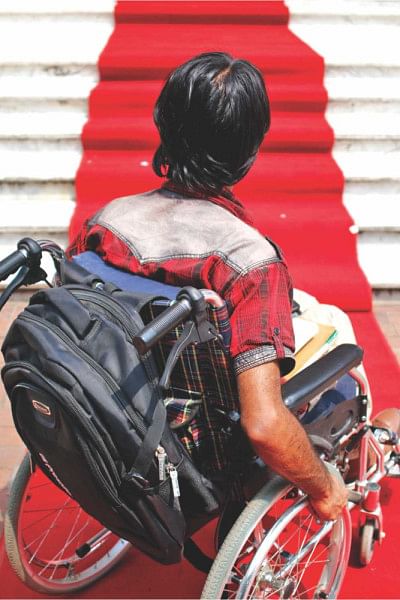Access Denied!

Photo: Kazi Tahsin Agaz Apurbo
Adil Mahbub lost his leg in a road accident when he was in grade seven. After the accident, Adil's studies came to a halt for a long seven years as no school agreed to enrol Adil, who is now wheelchair-bound.
“I was refused by many schools because classes were conducted in the upper floor of the school building where I, with my wheelchair, could not reach. Again, my parents also did not agree to enrol me in a school without residential facilities as it was almost impossible for me to go to a distant school every day by wheelchair,” says Adil. Finally, after seven years of searching, Adil and his family managed to find a school called Pangu Shishu Niketan Integrated High School in Rajshahi where the authorities agreed to enrol Adil and arranged residential facilities and classes in the ground floor of the school.
“After completing my secondary education, I had to go through similar struggles to get admitted to a higher secondary institution. After being repeatedly refused by some reputed institutions, I had to travel to Bogra to get admitted to a college to complete my higher secondary studies,” shares Adil.
Adil's determination to continue his studies paid off as he passed the tough admission test of Dhaka University and got admitted to the Department of Bengali. However, Adil's struggle was far from over. “For more than six months I could not attend a single class at my department as I was not allowed to stay in the dormitory due to my dependence on the wheelchair. Finally, the honourable Vice Chancellor intervened and a ramp and wheelchair-friendly toilet were built at Haji Muhammad Mohsin Hall where I am currently staying,” says Adil.
“However, I still have to solicit my friends' help to get to my classroom as most of the classrooms of Arts Building have steps at their entrances. And when the classes are arranged at the second or third floor of the Lecture Theatre Building where there is no lift, I have no alternative but to skip those classes,” adds a disappointed Adil.
Due to severe infrastructural barriers very few students with disability can complete their educational cycle. According to Centre for Disability in Development, there are around 15-20 million people with disabilities in Bangladesh. However, at present, the number of students with disabilities studying in Dhaka University is only 79. In other public universities of the country, the average number of students with disabilities is less than 50. It shows how the students with disabilities are deprived from their right to education.
Experts and students with disabilities blame poor accessibility resulting from infrastructural barriers for this bleak scenario. Afsan Chowdhury, a professor of BRAC University and former Director of Advocacy and Human Rights at BRAC, says, “In Bangladesh, persons with disabilities don't have access to public buildings at all. Streets and public transport are not at all disability-friendly. Very few higher educational institutions exist in Bangladesh which have disability-friendly buildings. Ultimately, students with disabilities simply cannot reach the educational institutions.”
In fact, except some institutions supported by NGOs and some private schools and colleges, very few secondary and higher secondary level educational institutions have disability-friendly structures in the premises. Whereas there are more than 100,000 primary schools in Bangladesh (Primary School Census, 2015), the Education Engineering Department has installed ramps and disability-friendly toilets only in around 2,000 schools and in some 1,500 madrasas. According to the officials, these facilities have been introduced mostly to the newly built structures and most of the old school buildings remain outside of the scope of their project.
Although some public universities have built ramps and wheelchair-friendly toilets, the situation is far from satisfactory. In Dhaka University, some ramps in the university dormitories are so steep that only motor cycle and bicycle users can use those ramps. Some buildings of the university have lifts; however, the lifts don't have any facilities that can tell visually impaired users which floor they are on and whether the door of the lift is opening or closing. And, in the entire university, only two buildings have a couple of toilets which can be used by wheelchair users.
Md Shamimjahan, assistant programme officer of Work for a Better Bangladesh Trust, recently conducted a survey on the accessibility of students with disabilities to public universities. He says, “Structural modification is necessary mainly for the physically handicapped and the visually impaired. At present, there are three wheelchair users studying in Dhaka University who have to suffer a lot due to the infrastructural barriers.”
“Most of the students with disabilities of Dhaka University are visually impaired; however, none of the buildings of the university has tactile floor which is essential for the safe mobility of the visually impaired,” adds Shamimjahan.
The chief engineer of Dhaka University, AK Afzalul Huq, claims that the authority has allocated adequate budget to make buildings disability-friendly and that they have already taken some initiatives to install ramps and toilets for the disabled.
In Bangladesh, there are two pieces of legislation, Bangladesh Building Construction Rules 2008 and Section 34 of Persons with Disabilities Rights and Protection Act 2013, which require every public structure of the country to be disability-friendly. However, the irony is that most of the government buildings, including the educational institutions, are not at all accessible to the people with disabilities. Every year, we lose a large number of talented students who drop out of formal schooling as our poor, unplanned infrastructure cannot accommodate the special needs of these students. Not only is it a massive waste of human potential, but it also testifies to the state's failure to protect the right to education – one of the most basic rights of citizens.

 For all latest news, follow The Daily Star's Google News channel.
For all latest news, follow The Daily Star's Google News channel. 



Comments